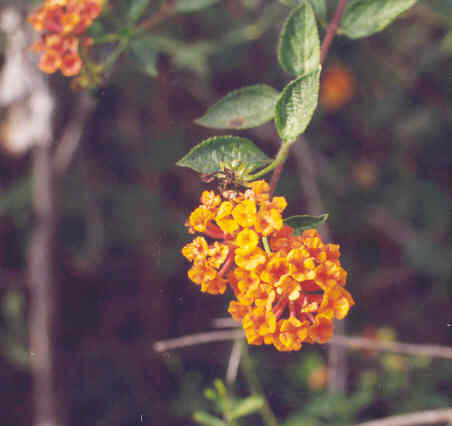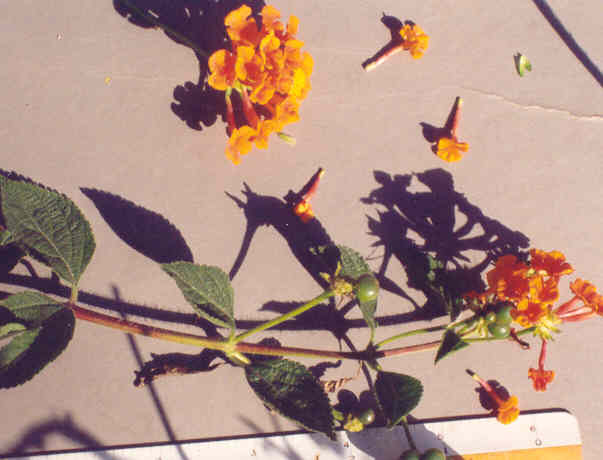
Lantana camara L.
 |
Lantana camara L.
Verbenaceae (Vervain Family)Tropical AmericaLantana |
March Photo
Plant Characteristics:
Shrub to 6 ft. or more, covered with stiff hairs, unarmed, lvs. ovate or
oblong-ovate, 1-5 in. long, mostly short-acuminate, crenate-dentate,
short-petioled, rather thick, rugose, scabrous above, +/- pubescent beneath;
heads dense, 1-2 in. across, flat topped, on stout axillary peduncles often
longer than lvs.; bracts narrow, about half as long as corolla; fls. 1/4-1/2 in.
long, usually opening yellow or orange but changing to red or scarlet; calyx
very small; corolla somewhat irregularly 4-5 parted but not bilabiate, the tube
slender; stamens 4, didynamous, attached midway in the tube, included; ovary
2-celled, becoming a fleshy drupe with 2 bony nutlets.
Habitat:
Tropical America north to Texas and south Georgia.
(Bailey 842). Disturbed
slopes, abandoned fields, urban weed below 200 meters.
Southern counties as a waif; naturalized +/-worldwide; perhaps native to
Caribbean. (Hickman, Ed. 1086).
Escape from cultivation.
Name:
Lanta-na, old Latin name, also applied to Viburnum, which it
resembles. Camara, a South
American name. (Bailey 842).
General:
Rare in the study area with only one plant known and this on the
northerly side of Big Canyon near Back Bay Dr.
The plant was obscured by stand of Castor Bean and while cutting these
plants down as a volunteer for the Fish & Game, I discovered the Lantana.
Subsequent t my first finding this plant, it has spread and has now (2005)
covered a large section of the bluff in that area. (my comments). Crushed foliage has strong,
pungent odor that is objectionable to some people.
Birds are attracted to the plant. (Sunset
Editors, New Western Garden Book 1984. 344). Both foliage and ripe berries contain a
toxic substance. Especially
dangerous to eat are the green berries for they have a higher concentration of
the poison. Hybridizers have
developed many varieties of lantana and all species are suspected of causing
poisoning. Lantana is rated as one
of the main causes of poisoning in Florida.
Generally symptoms of poisoning occur within a day after consuming the
poisonous parts. They consist of
severe stomach and intestinal upset, weakened muscles, rapid heartbeat, and
difficulty in breathing. The
kidneys are affected and sensitivity to sunlight is shown.
If the vessels carrying blood to the heart collapse, death quickly
follows. (James 43).
Text Ref:
Bailey 842; Hickman Ed. 1086; Munz, Flora So. Calif. 850; Sunset
Editors, New Western Garden Book 1984. 344.
Photo Ref:
Oct 96 Jan 97 # 1A, 3A.
Identity: by R. De Ruff, confirmed by John Johnson.
First Found: October 1996.
Computer Ref: Plant Data 499.
Plant specimen donated to UC Riverside in 2004.
Last Edit 8/8/05.
 |
March Photo